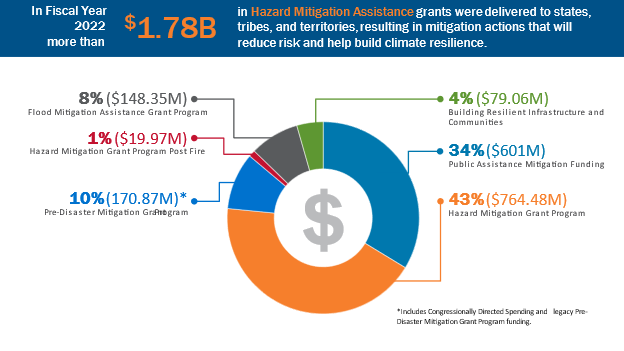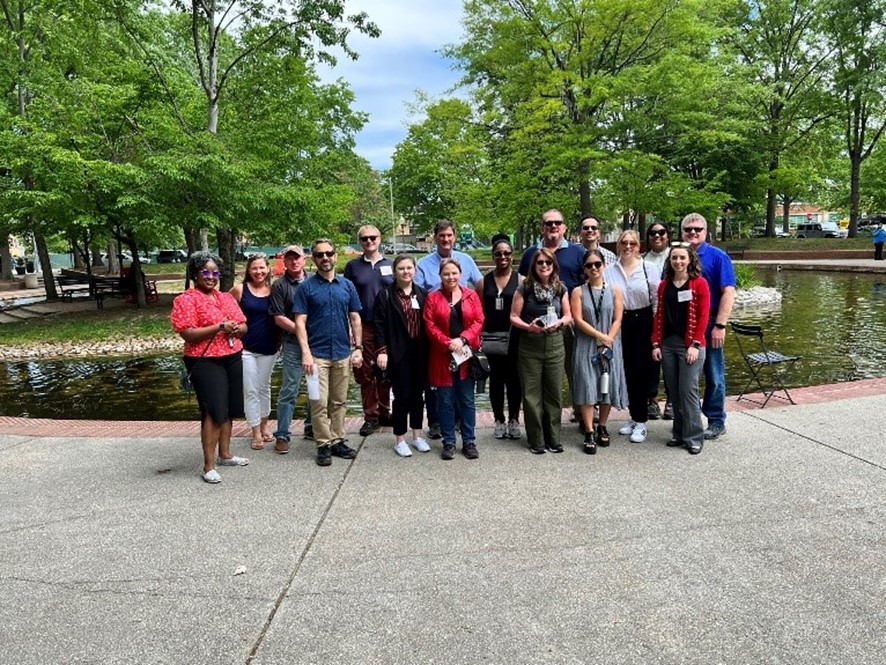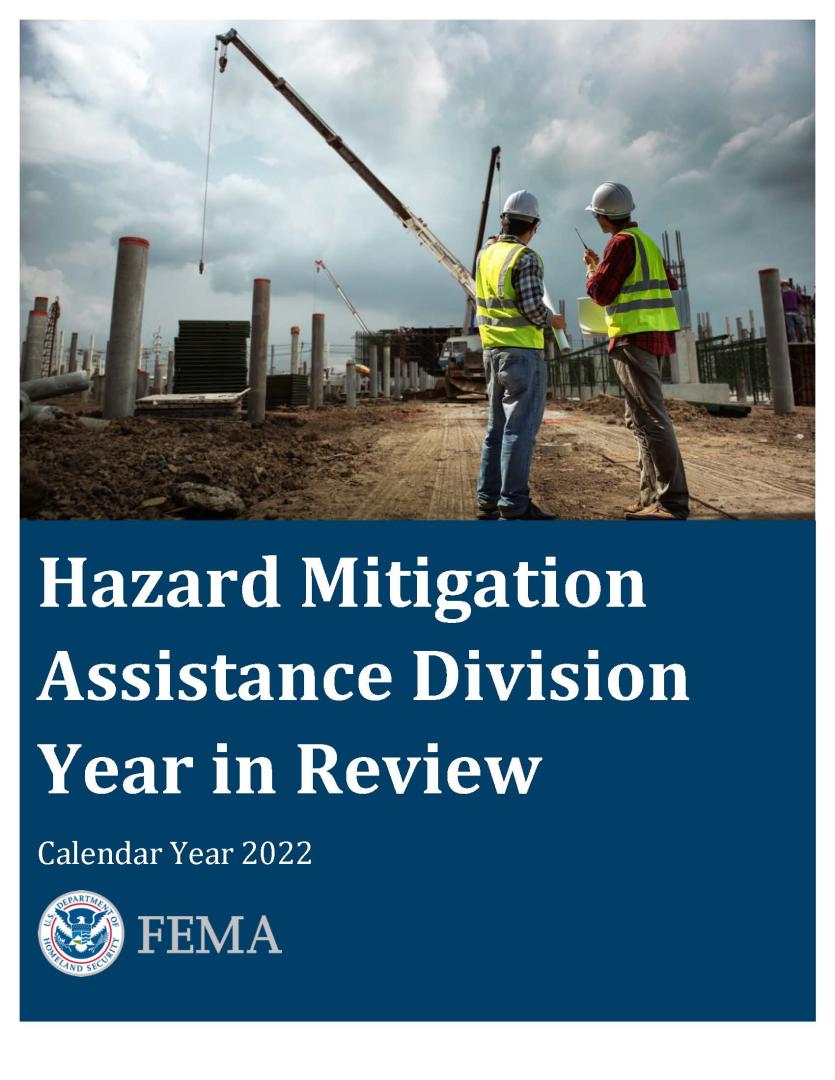The Hazard Mitigation Assistance (HMA) Division works closely with federal partners and support state, local, tribal, and territorial governments to reduce nationwide vulnerability to disasters and natural hazards.
Our vision is helping build a prepared and resilient nation, while our mission is helping people reduce disaster risk through partnerships and mitigation investments to increase resilience. Our values align with the FEMA core values of compassion, fairness, integrity, and respect. We also seek to promote equity, efficiency, and collaboration in achieving our mission.
View Previous Year in Reviews

This chart details the amount of funding that was awarded by the HMA Division and Public Assistance Mitigation in FY 2022, broken down by program.
Main Highlights in this Year's Update
This report has several key topics about FEMA’s Hazard Mitigation Assistance grants.
Reduce Risk
FEMA’s HMA Division continues to help reduce risk through the delivery of several grant programs that provide mitigation funding to significantly reduce the impact of disasters and natural hazards on people’s lives and communities.
- For a second year, FEMA made a historic amount of funding available for the fiscal year (FY) 2022 BRIC and FMA grant programs. The FY 2022 BRIC and FMA funding opportunities also infuse more than $800 million through the Infrastructure Investment and Jobs Act (IIJA), more commonly known as the Bipartisan Infrastructure Law (BIL).
- For HMGP, FEMA made $3.46 billion available for the COVID-19 disaster declarations in all 59 states and territories and three federally recognized tribes that received major disaster declarations.
- For the congressionally directed funding through the PDM grant program for FY 2022 announced in May 2022, FEMA successfully awarded 70 subapplications for a total federal share of $134.67 million. We awarded these grants to 26 states and two tribes. This was a significant undertaking for our regional and national HMA teams.
- FEMA launched the FMA Swift Current initiative in March 2022 and has been able to allocate $60 million to Louisiana, Mississippi, New Jersey, and Pennsylvania—all states affected by Hurricane Ida—to equitably expedite mitigation flood grants to disaster survivors with repetitively flooded homes. These funds will help them reduce or eliminate repetitive flood damage to buildings insured through the National Flood Insurance Program (NFIP).
Promote Equity
The HMA Division is reducing barriers, providing focused assistance to underserved communities, and simplifying the mitigation assistance process to ensure our partners have straightforward and equitable access to mitigation grant programs.
- Executive Order 13985, Advancing Racial Equity and Support for Underserved Communities Through the Federal Government. HMA completed an equity assessment of our programs that help advance our efforts to direct program benefits to underserved communities. The findings from the assessment informed the development of an action plan to meet the equity outcomes addressed in EO 13985.
Justice40 Initiative through Executive Order 14008. In 2022, FEMA applied equity considerations for the first time to the BRIC and FMA program, using an interim data equity standard to measure progress toward the Justice40 Initiative. As a result of selections made for the FY 2021 BRIC and FMA programs, FEMA is delivering over $508 million in climate resilience funding toward Justice40 communities. This accounts for 44% of the $1.16 billion made available during this funding cycle.
- Changes in Benefit-Cost Analysis. The Benefit-Cost Analysis (BCA) program managed and released several improvements to the program and procedures in 2022. For the FY 2022 BRIC and FMA programs, for the first time, projects can be analyzed at the 3% discount rate when certain conditions are met. The BRIC and FMA programs will also perform the BCA for the most at-risk communities. FEMA also announced a new effort that will reduce the burden of applying for BRIC and FMA funding for disadvantaged communities and may make it easier for projects with nature-based solutions to access funding. FEMA introduced an alternative cost-effectiveness method that will modify the threshold for mitigation projects to be cost-effective under limited conditions.
Build Capacity
The HMA Division builds a prepared and resilient nation by ensuring stakeholders have access to all available programs, tools, training, and resources.
- Swift Current Initiative. FEMA's FMA program launched a $60 million disaster initiative called Swift Current that distributed funding in better alignment with the survivor experience. The FMA Swift Current Initiative is intended to explore how to make flood mitigation assistance available within the disaster recovery timeframe, for repetitively flooded and substantially damaged buildings insured under the NFIP in advance of the annual grant process.
- BRIC non-financial Direct Technical Assistance. For FY 2022, the BRIC program prioritized assistance that benefits disadvantaged communities through BRIC non-financial DTA to build capability and capacity. For the FY 2022 cycle, FEMA announced 40 communities will be selected for the BRIC DTA initiative, which will increase the capacity and capability of many more communities and help strengthen resilience throughout the country.
- Updated and accessible program support materials are maintained in HMA’s robust library of educational materials to ensure stakeholders are proficient in all HMA grant programs and changes to policies and the programs. In addition, in 2022 HMGP developed a series of project-type specific guidance and support materials to help subapplicants submit complete and eligible applications. The materials cover 13 of the most requested HMGP project types.
- Hazard Mitigation Assistance Webinars. HMGP launched its first national webinar series in the spring of 2022 to support SLTT capability and capacity building efforts and increase program awareness.
- HMA Guide Update. The HMA Division continued its effort to update the Hazard Mitigation Assistance Program and Policy Guide (HMA Guide), which replaced the 2015 HMA Guidance and HMA Guidance Addendum. The purpose of the update was to incorporate existing policies published after the release of the 2015 HMA Guidance and to reflect various other changes, including the new BRIC program.
Foster Connections
FEMA’s HMA Division works closely with federal partners, states, local communities, tribes, and territories to help them consider risk and mitigation in all investment decisions. For the first time in more than two years, the HMA External Stakeholder Working Group (ESWG) returned to in-person meetings to foster stronger connections between members, FEMA, and local staff, and to gain new perspectives from members on local mitigation endeavors.

Looking Ahead
The past year brought change to the HMA Division and billions of dollars in funding through new executive orders, initiatives, and IIJA, more commonly known as the BIL.
We remain flexible and ready to adapt despite the challenges of climate change and increasing disaster risks. FEMA continues to evolve mitigation grants to be more equitable, reduce complexity, and address climate resilience. FEMA also remains focused on reducing barriers to accessing funding to those who need it the most and building capacity and capability to deliver mitigation grant programs. In this incoming year, HMA will continue to support FEMA’s vision for a prepared and resilient nation with a “people first” approach.



